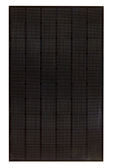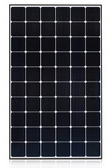 Loading... Please wait...
Loading... Please wait...- Home
- Solaris Blog
- LG vs Panasonic Solar: The Complete Review
Products
- Heating and Cooling
- Outdoor Living & Patio
- Solar Kits
- Solar Products
- Solar Panels
- Solar Panel Kits
- Solar Generators
- Inverters
- Inverter Monitoring
- Inverter Accessories
- Balance of Systems
- Racking and Mounting
- Rails
- Flashings
- Splice Kits
- Stopper Sleeves
- Conduit Mounts
- Attachments
- Brace Assembly
- Base Mount
- Brackets
- Bolts
- Clamps
- Caps
- L-Feet
- Washers
- Skirt
- Lugs
- Tilt Legs
- Hooks
- Stand-Offs
- Ballast Bay
- Top of Pole Mount
- Side of Pole Mount
- Flush Mount Kits
- Ground Mount Kits
- Roof Mount Kits
- Hardware Packages
- Wire Management
- Batteries
- Battery Accessories
- Charge Controllers
- Tools and Supplies
- View All Products
LG vs Panasonic Solar: The Complete Review
Posted by Brandi Casey on 7th Apr 2020

LG Solar and Panasonic Solar are leaders of premium, high-efficiency solar panels, that are backed by industry leading warranties by the two globally recognized manufacturers. Together, they dominate in efficiency and durability, while delivering additional benefits through their innovative solar panel designs. Solar system installations utilizing LG and Panasonic solar panels benefit from their high-efficiency technology as well as the knowledge that their solar power system is backed by a trusted manufacturer.
LG Solar and Panasonic Solar utilize a number of solar panel and cell technology in order to enhance solar energy output, increase durability and reliability to enhance your long-term investment. LG Solar’s modules are primarily 60 cell, while providing specialty modules including: bifacial, AC solar panels (microinverters included), and commercial.
Panasonic’s solar panels are designed with 96 cells and their specialty offerings also include bifacial, AC solar modules and commercial specific panels. Both manufacturer’s modules are ideal for both residential and commercial installations with a few exceptions, such as commercial specific panels. We will be comparing solar modules compatible with both residential and commercial installations.
In this LG vs Panasonic solar panel review, we will explore the following:
- Specifications and Technology
- Average Cost per Module
- Potential ROI
- Warranty and Degradation Rate
- And Solaris Recommendations
Specifications and Technology
LG and Panasonic utilize different technologies in order to accomplish their high energy output and long expected life-time performance. LG’s solar panels use N-Type solar cells, which use phosphorous – this leads to less LID (Light Induced Degradation) after installation and over the lifetime of the solar modules. Meaning, the solar panels have a lower degradation rate, and higher energy output. In addition, the cells add to the module’s low temperature coefficient, which increases the modules performance on hot, sunny days, when potential hot spots can occur.
Panasonic’s solar cells utilize silicon layers that reduce electron carrier loss, resulting in high-efficiency solar modules with long-term energy output. In addition, the cells uniquely designed pyramid structure reduces outward reflection and directs the rays directly into the cell. The 96 cell design is unique to Panasonic, however, this design does not drastically decrease their compatibility with other necessary solar energy components (such as inverters, racking, etc.).
 |
Model # | Max. Power | Efficiency | Cell Count | Information |
 |
LG320N1K-V5 |
320 Watts |
18.7% |
60 Cell |
Pricing Specifications Warranty |
 |
LG340N1C-V5 |
340 Watts |
19.8% |
60 Cells |
Pricing Specifications Warranty |
 |
LG375A1C-V5 w/ LG Microinverter |
375 Watts |
21.7% |
60 Cells |
Pricing Specifications Warranty |
| Avg. Watts: | 345 Watts | Avg. Efficiency: | 20.07% | ||
 |
Model Number | Watts | Efficiency | Cell Count | Downloads |
 |
VBHN320KA03 |
320 Watts |
19.1% |
96 Cell |
Pricing Specifications Warranty |
 |
VBHN340SA17 |
340 Watts |
20.3% |
96 Cell |
Pricing Specifications Warranty |
 |
VBHN330SA17E w/ Enphase Energy Microinverter |
330 Watts |
22.1% |
96 Cell |
Pricing Specifications Warranty |
| Avg. Watts: | 330 Watts | Avg. Efficiency: | 20.05% |
*Selection of modules include mid-watt, high watt and AC modules (panels with microinverters) for comparison. More options are available for LG Solar here and Panasonic here.
Winner: Tie
LG Solar, on average, carries higher watt modules than Panasonic. However, both manufacturers produce modules that are on par with one another in terms of efficiency. Either choice would provide industry leading energy yield.
Average Cost
per Module
The below table reflects cost averages based on the average output of premium manufactures LG Solar and Panasonic in comparison with mid-range panel option represented by Mission Solar, and finally, the value based module represented by Trina Solar. LG's solar panels average cost is $0.81/watt; while Panasonic's average cost starts at $0.78/watt.
When compared with mid-range and value based solar panels, the premium panels come in at a higher cost per watt, with higher output and longer performance warranty periods. Panasonic and LG solar are close in both cost and average efficiency and matched in performance output. To calculate your potential savings and ROI period, refer to the Warranty and Degradation Rate section for further details.
| Manufacturer | Average Cost | Average Efficiency | Warranty |
| LG Solar | $0.81/watt |
20.07% |
25-yr Product | 25-yr Performance |
| Panasonic | $0.78/watt | 20.05% |
25-yr Product | 25-yr Performance |
| Trina Solar | $0.65/watt | 19.24% |
10-yr Product | 25-yr Performance |
| Mission Solar | $0.71/watt | 18.96% | 12-yr Product | 25-yr Performance |
*Average cost and efficiency based on pricing and ratings as of the posting of this article.
Winner - Panasonic
Panasonic comes out slightly ahead of LG Solar at $0.03/watt less on average. In terms of their additional benefits like average efficiency rating and warranty period, they are tied.
Potential ROI
In order assist in calculating your potential ROI, we have designed to similar composition roof top systems utilizing an average usage of 900kWh per month for a system in Zone 2. The recommended system size with these average measurements is approximately 8kW.
For the purposes of comparison, we will be using one high watt panel and one AC panel from both LG and Panasonic. The high-watt panel from LG is the LG340N1C-V5, while the Panasonic's panel is the VBHN340SA17. The AC panel from LG is the LG375A1C-V5, while Panasonic's panel is the VBHN330SA17E.
- High-Watt Systems
- LG Solar - 340 watts x 24 panels = 8,160 watts or a 8.16kW System
- Panasonic Solar - 340 watts x 24 panels = 8,160 watts or a 8.16kW System
- AC Systems
- LG Solar - 375 watts x 22 panels = 8,250 watts or a 8.25kW System
- Panasonic Solar - 330 watts x 24 = 7,920 watts or a 7.92kW System
- LG Solar - 375 watts x 22 panels = 8,250 watts or a 8.25kW System
Both high watt systems will use a SolarEdge string inverter with optimizers. The AC systems will utilize their existing built-in microinverters (LG micros for the LG modules and Enphase Energy for Panasonic), in addition to monitoring and accessories. All systems will be built with IronRidge XR100 racking in an even 2 by x configuration (ex. 2x rows and 12x columns for the both high-watt systems). Racking will include the rails, mounts, clamps, grounding lugs and all necessary equipment for mounting the solar panels on a shingle roof. Both systems also include permitting services with no addition engineering stamps.
The below system does not include: State and Federal Tax Rebates, and balance of systems items (such as PV wire, disconnect boxes, circuit breakers, etc.). Be sure to calculate all tax rebates and average between $200 - $500 for the additional balance of systems items for roof mounted systems. Engineering stamps for structural, electrical or both may be required by some counties, check with your city planning office to see if they have any such requirements.
High-Watt Solar Systems
LG Solar |
Panasonic Solar |
|
| Solar Panels | LG340N1C-V5 | VBHN340SA17 |
| Inverters | SolarEdge SE7600H-US | SolarEdge SE7600H-US |
| Optimizers | P370 | P405 |
| Roof Mount Racking | IronRidge XR100 Comp. Roof Mount Kit | IronRidge XR100 Comp. Roof Mount Kit |
| Other |
Permit Plan Set Labels |
Permit Plan Set Labels |
| Sub Total | $13,188.49 | $14,962.49 |
| Est. Shipping | $360.00 | $370.00 |
| Avg. Total | $13,548.49 | $14,962.49 |
*Pricing calculated based on pricing as of the posting of this article. Learn more about how to size your system here, to request a system quote fill out our intake form here.
High Watt Systems Investment Cost
LG Solar's system comes in lower than Panasonic's system, by about $1,800. This is in part due to the cost of the modules as well as the necessity of using a higher watt optimizer with Panasonic solar panels.
- LG Solar - $13,548.49 / 8,160 Watts = $1.66/watt
- Panasonic Solar - $14,962.49 / 8,160 Watts = $1.84/watt
Energy Production
Both systems will produce around 900kWh per month, by taking the average cost per kilowatt hour for the United States ($0.13), we can determine that both systems provide about $108 in monthly savings every year.
- 900kWh x $0.13 = $117 monthly savings
ROI Period
Based on the bill of materials above, and excluding outside rebates and expenses, the ROI period of the above systems are as follows:
- LG Solar - $13,548.49 / $117 = ~115.8 months or 9.65 year ROI period
- Panasonic Solar - $14,962.49 / $117 = ~127.88 months or 10.65 year ROI period
The systems are nearly identical in terms the overall bill of materials, excluding the optimizers as previously mentioned.
AC Solar Systems
LG Solar |
Panasonic Solar |
|
| Solar Panels | LG375A1C-V5 | VBHN330SA17E |
| Microinverters (Included) |
LG LM320UE-A2 |
Enphase IQ7X-96-2-US |
| Accessories |
Trunk Cable Disconnect Tool |
Trunk Cable Termination Caps Disconnect Tool |
| Monitoring | EnerBox2 |
IQ+ Combiner with Envoy |
| Roof Mount Racking | IronRidge XR100 Comp. Roof Mount Kit | IronRidge XR100 Comp. Roof Mount Kit |
| Other |
Permit Plan Set Labels |
Permit Plan Set Labels |
| Sub Total | $16,443.68 | $15,091.30 |
| Est. Shipping | $350.00 | $380.00 |
| Avg. Total | $16,793.68 |
$15,471.30 |
*Pricing calculated based on pricing as of the posting of this article. Learn more about how to size your system here, to request a system quote fill out our intake form here.
AC Systems Investment Cost
Here, Panasonic's solar energy system comes in lower than LG Solar by about $1,300. The majority of the cost difference is due to the different microinverters used between each module. Also keep in mind that there is more wattage from the LG Solar system with fewer modules.
- LG Solar - $16,793.68/ 8,250 Watts = $2.04/watt
- Panasonic Solar - $15,471.30 / 7,920 Watts = $1.95/watt
Energy Production
Both systems will produce around 900kWh per month, by taking the average cost per kilowatt hour for the United States ($0.13), we can determine that both systems provide about $108 in monthly savings every year.
- 900kWh x $0.13 = $117 monthly savings
ROI Period
Based on the bill of materials above, and excluding outside rebates and expenses, the ROI period of the above systems are as follows:
- LG Solar - $16,793.68 / $117 = ~143.5 months or 11.96 year ROI period
- Panasonic Solar - $15,471.30 / $117 = ~132.3 months or 11.01 year ROI period
The systems are nearly identical in the bill of materials, excluding their microinverters and inverter accessories.
Winner - Tie
Both LG and Panasonic offer solar panel solutions between the high watt panel and AC panel system that out compete one another in pricing. Both DC modules (panels without microinverters) can be used with microinverters that are sold separately.
Warranty and Degradation Rate
The warranty time period of solar modules and the degradation rate can assist you in accounting for your future energy savings. LG and Panasonic offer industry leading warranties with 25 year product and 25 year performance.
The linear performance warranty covers how much of the nameplate power you can expect to lose as the panel ages. Degradation rate is the rate at which the panel degrades, the lower the better, while expected output at the 25 year benchmark is the guaranteed amount of power the panel will be producing at that time, in this case, higher is better.
|
Degradation Rate
|
25 Year Output
|
|
| LG Solar |
2% (yr 1), 0.33% (yrs 2-25+)
|
90.08% |
|
Panasonic Solar |
3% (yr 1), 0.26% (yrs 2-25+)
|
90.76% |
The average degradation rate of the solar panels is similar, with only 0.68% difference between the Pmax output of the solar modules at 25 years. Panasonic starts off with a higher degradation rate in the first year than LG, while LG has a higher degradation rate between the second and twenty-fifth year.
- LG Solar 340w Panel - 340 Watts x .9008 = 306.27 Watts at 25 yrs
- Panasonic Solar 340w Panel - 340 Watts x 0.9076 = 308.58 Watts at 25 yrs
The degradation rate should be calculated when sizing out your solar energy system in order to plan for your future energy use, in general, it is recommended to oversize your solar energy system, particularly when 100% energy coverage is required.
Winner - Tie
LG and Panasonic both offer industry leading warranties, the lowest degradation rates, and highest 25 year Pmax output. On average, value based and mid range panels provide between 80-87% output at the 25 year benchmark set by their warranty periods. In addition the product warranty is a little over half of what LG and Panasonic provide.
Solaris Recommendations
LG Solar and Panasonic Solar both provide solar panels with industry leading efficiency, reliability and durability. Future panel efficiency and output is significantly higher than the industry average (80% - 87%) at the 25 year benchmark, meaning more energy will be produced from both LG and Panasonic solar panels than industry standard panels. Both manufacturers offer the most extensive and expansive solar module warranties available - backed by trusted, world recognized brands.
While there are minor differences between the technologies and some costs associated with both LG and Panasonic solar panels when compared, they are more similar than dissimilar in terms of what you can expect from their energy output and reliability. Costs associated with both manufacturers varies, when averaged, with the most significant difference in cost arising between the AC modules with LG microinverters and Panasonic panels with Enphase Energy microinverters. The overall system cost for an LG with Enphase microinverters and Panasonic with the same components are closer in cost per watt overall than the AC modules.
Premium solar panel lines like those from LG and Panasonic offer realistic value through their high efficiency technologies, and peace of mind when planning for future energy usage. Premium modules come in at a higher price point and have a longer ROI period than mid-range panels by about 0.8-1 year on average, however, system owners will benefit from 10%+ more output power at the 25 year benchmark. LG and Panasonic solar modules are worth considering for your next solar system project, while they come at a higher cost, this cost is offset by the numerous benefits the modules provide.
See Here: Hanwha Q Cells vs Trina Solar: What’s Best?





